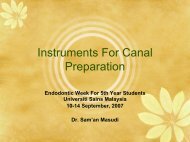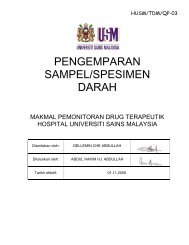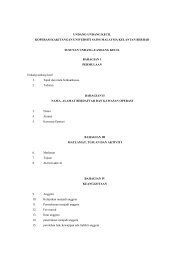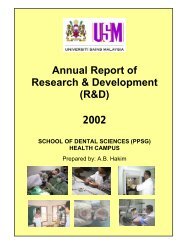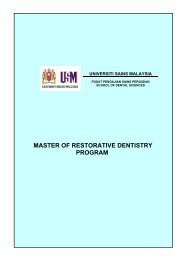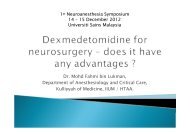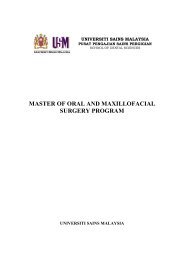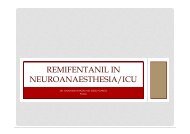Vol 11-R2- Eyelid
Vol 11-R2- Eyelid
Vol 11-R2- Eyelid
Create successful ePaper yourself
Turn your PDF publications into a flip-book with our unique Google optimized e-Paper software.
SRPS • <strong>Vol</strong>ume <strong>11</strong> • Issue <strong>R2</strong> • 2010<br />
functional and cosmetic results and only two<br />
required secondary repair. Zitelli 160 divided the<br />
regions of the face into three groups—NEET,<br />
NOCH, and FAIR—and reported the results of<br />
secondary intention healing. The NEET areas are<br />
the concave areas of the face, including the nose,<br />
eye, ear, and temple, and they tend to heal with<br />
excellent cosmetic results. The NOCH areas are<br />
the convex surfaces, including the nose, oral lips,<br />
cheeks, chin, and helix of the ear, and they produce<br />
noticeable scars. The FAIR areas are the flat<br />
surfaces, including the forehead, antihelix, eye lid,<br />
and remainder of the nose, lips, and cheek, and they<br />
achieve intermediate results.<br />
Ceilley et al. 161 described the use of secondary<br />
intention healing to delay skin grafting, either full<br />
thickness or split thickness. The authors postulated<br />
that partial healing of deep wound defects by<br />
secondary intention will produce a wound that is<br />
much smaller and of more normal contour than<br />
the original wound and is therefore more amenable<br />
to skin grafting. They warned, however, that areas<br />
requiring constant protection (i.e., the central<br />
eyelid) might require immediate grafting or flap<br />
reconstruction to avoid exposure keratopathy.<br />
Appropriate repair of medial canthal defects<br />
is crucial to ensure proper functioning of the eyelid<br />
and lacrimal system and creation of an aesthetically<br />
acceptable result. A number of approaches to this<br />
type of repair are described in the literature and<br />
have been proven to be effective. In choosing the<br />
most suitable repair, a variety of factors should be<br />
considered, including the size and depth of the<br />
defect and involvement of the lacrimal system.<br />
Additionally, it must be recognized that all the<br />
techniques described above do not exist in isolation.<br />
A combination of two or more techniques often is<br />
needed in closing medial canthal defects.<br />
Lateral Canthal Defects<br />
Proper repair of the lateral canthal region is an<br />
important issue in facial aesthetics. Improper<br />
repair can lead to cosmetic deformity or functional<br />
failure caused by eyelid malposition. The crucial<br />
issue in the reconstruction of the lateral canthus is<br />
40<br />
its position and shape. Any tissue rearrangement<br />
around the lateral canthus should not exert undue<br />
tension on the lateral canthus. Even minor changes<br />
are noticeable and could lead to poor cosmetic<br />
results. Inadequate support to the lateral canthus<br />
can lead to blepharophimosis, rounding of the<br />
lateral canthal angle, slanting of the lateral canthal<br />
angle, ectropion, inferior scleral show, and exposure.<br />
Numerous approaches can be used to repair defects<br />
in the lateral canthal region, including primary<br />
closure, skin grafting, and regional advancement<br />
flaps. Although a majority of lateral canthal defects<br />
can be repaired by techniques previously described<br />
for the upper and lower eyelid reconstruction<br />
sections, in cases of larger or more complex<br />
defects, the following flaps have been described as<br />
being useful.<br />
Bilobed Flap<br />
In 2007, Mehta and Olver 162 described achieving<br />
great success by using a bilobed flap for<br />
reconstructing the lateral canthal area. The flaps<br />
used in that study originated in the zygomatic or<br />
lateral cheek region. This advancement flap consists<br />
of two lobes with one common base that can be<br />
mobilized and rotated into place to cover the defect.<br />
The first lobe is slightly smaller than the defect,<br />
and the second lobe usually is one-half the width<br />
of the first lobe. The design allows the defect from<br />
the second flap to be closed primarily. To avoid skin<br />
tension, the flap should be based superiorly in a<br />
design with which the second flap is elevated from<br />
the preauricular region horizontally and the first<br />
flap is elevated in a vertical orientation. By elevating<br />
the second flap from the preauricular region with a<br />
horizontal orientation, the closure line can be placed<br />
parallel to the crow’s feet. 162<br />
The approach provides excellent color and<br />
texture matches. Additionally, ectropion is not<br />
commonly encountered because the flap is based<br />
superiorly. However, the length of the scar is<br />
considered a disadvantage. Additionally, in male<br />
patients, the second lobe of the flap might contain<br />
some hair-bearing skin.




